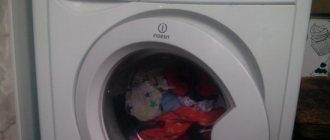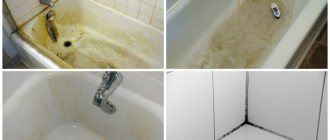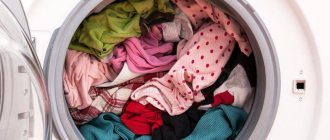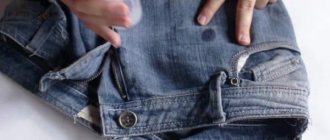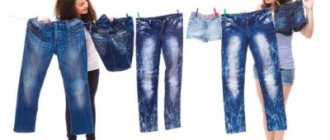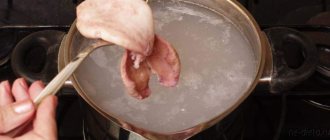How to properly care for your bra
The fact that underwear requires special care is no secret. But, knowing some tricks, you can keep your bra in perfect condition for a fairly long period.
One of the main rules that will help extend the life of underwear is delicate washing. It is best to wash this item of clothing separately from others. Remember that hand washing is the most gentle. This is especially true for those lingerie models that contain lace inserts and various decorative details. But machine washing is also considered an acceptable option if you choose a delicate cycle and use special bags. Another common mistake is roughly squeezing the underwear after washing, twisting it forcefully to remove the maximum amount of moisture. This is strictly prohibited. Just use gentle movements to remove excess water.
It is better if most of it drains on its own when the underwear is already hung (here it is important to straighten the bra: the cups should not be turned inside out). The fact is that squeezing movements deform the fabric.
In addition, this also negatively affects the padding of the bra: it loses its shape, dents and creases appear on it. One of the most common blunders is using too hot water for washing. This not only negatively affects the color of the product, but also destroys the fibers of the fabric. If you wash your bra regularly in this way, it will last much less and will quickly lose its original appearance. Neglecting sorting is the next gross violation of the rules for washing underwear. You can’t wash white and colored clothes together: if the darker version fades, the light-colored bra will inevitably be damaged. You should not take such risks; it is better to wash such items separately from each other, dividing them into groups in advance depending on color and material.
Helpful tips for drying and storage
To ensure that your laundry lasts a long time, it is important to handle it correctly. Even the most delicate laundry detergent will not correct storage and drying defects. Some useful tips for caring for things:
- A newly purchased bra should be washed before wearing for the first time.
- You need to wash your bra after every third wearing (for colored) or every second (for white).
- You should not press the bra with your hands, especially with a push-up bra and underwires - this can tear it and ruin the shape.
- The faster dirty laundry is washed, the better.
- You need to dry things on a horizontal surface or in a dryer; do not use hot air.
- A guipure bra should not be hung on a drying rack with metal rods - it may tear.
- Ironing underwear is not recommended.
- Clean bras should be stored in a special drawer; it should be spacious enough.
Compliance with these rules extends the life of things. You don’t have to have a lot of bras at once; handling them correctly will help you enjoy good underwear for a long time. Regular showering and changing clothes are also useful - then the laundry will get dirty less.
Wash your bra before wearing it for the first time
Wash your bra after every second wearing.
Do not use hot air when drying
Store clean bras in a special drawer.
It is not recommended to iron underwear
A guipure bra should not be hung on a metal drying rack.
Bra Whitening Methods
To return the original color to a white bra at home, you need to familiarize yourself with the composition of the fabric. Not all bleaching methods are equally suitable for bras made of synthetic and natural materials. Cotton and similar fabrics are easy to care for. Synthetic linen may deteriorate if aggressive bleaching agents are used.
| Natural fabrics | White |
| Boiling | |
| Soda and salt | |
| Blue | |
| Synthetics | Hydrogen peroxide |
| Ammonia | |
| Vinegar |
Other bleaching options are applied to artificial and natural materials.
Ammonia or hydrogen peroxide
Ammonia can be used to bleach bras made from synthetic and natural materials. To lighten, you need to do the following:
- 6 tbsp. Dilute ammonia in 3 liters of water;
- leave the bra in the composition for 2 hours;
- wash in a convenient way.
When you need to wash more than 1 set, you should increase the volume of water and add alcohol at the rate of 1 tbsp. per 1 liter.
You can change the proportions in case of heavy contamination: take 5 tbsp for 5 liters of warm water. alcohol Soaking time for the product is 2-12 hours.
Hydrogen peroxide is used not only for medical purposes, but also to lighten a variety of materials at home. It is suitable for processing delicate types of fabrics. Whitening recipe:
- For 2 liters of water you need to take 2 tbsp. peroxides;
- the item is left in the solution for 20 minutes, if heavily soiled - for 2 hours;
- the product is thoroughly rinsed.
Old dirt on underwear can be removed by strengthening the composition with 1 tsp. ammonia. After soaking, you need to wash the product with soapy water.
Salt, soda
Baking soda and salt can remove traces of sweat and other dirt from your bra at home. The composition for whitening bras made from natural fabrics (without guipure, colored or black inserts) is prepared as follows:
- 3 liters of water are heated to room temperature;
- add 2 tbsp. salt and 3 tbsp. baking soda;
- salt and soda should dissolve without residue.
Linen is dipped into the solution and soaked for 30 minutes. The bra is rinsed in warm and then in cold water.
Blue
Blue is not used for bleaching bras made of artificial and delicate fabrics at home. It can give cotton linen a snow-white tint. The substance is added along with the powder during washing, or the bra is then soaked in the solution.
It is impossible to immediately determine the required proportions of the substance and water. Fabrics react to bluing in different ways. First you need to dissolve 1 pinch of blue in 1 liter of water. The solution should be a pale blue color. In the absence of the planned effect, the mass of the powder needs to be gradually increased.
Laundry soap
It is possible to return the white color to underwear using laundry soap. To prepare a soapy bleach solution, do the following:
- grate a bar of soap;
- add 1 glass of warm water to the grated soap;
- bring the solution to homogeneity;
- pour the composition into a container for washing clothes.
You can leave the bra in the soapy solution for 30 minutes.
You cannot rub the product vigorously with this solution while washing, as it can damage its structure.
After washing at home, you need to rinse the bra in a significant volume of water at room temperature.
other methods
Organic acids are suitable for bleaching underwear made from synthetic fabrics at home. An effective option is acetylsalicylic acid:
- 5 aspirin tablets crushed;
- the resulting powder is added to 3 liters of cool water;
- the bra is placed in the liquid for 7 hours;
- The product is washed in the usual way.
To maintain the whiteness of your underwear, you can add 3 tablets of crushed aspirin to the powder with each machine wash.
When sewing bras, a variety of synthetic fabrics are used - satin, satin, lace. Vinegar is used to restore their whiteness. The whitening composition is prepared at the rate of 10 tbsp. vinegar essence per 1 liter of warm water. The product is kept in the solution for 6-12 hours. Afterwards you need to wash your clothes in the usual way.
Citric acid is one of the folk remedies that is used to bleach yellowed or gray fabrics. But you can’t use it to wash your bra at home in every case. It is only good for products made from dense natural materials. The bleaching agent is prepared at the rate of 1 tbsp. acid per 1 liter of warm water. Soak for 1 hour, after which the bra should be washed.
Cleansing with vinegar
Vinegar is also very effective in whitening underwear. However, using this whitening method is time-consuming. Since the underwear will need to be soaked overnight in a mixture of water and vinegar. To prepare the mixture, you will need to mix vinegar with warm water; the proportions must be calculated based on the fact that for one glass of warm water you need to add 2 tablespoons of vinegar.
How to bleach gray and yellow underwear without boiling
Bleaching things is not a very complicated process, but it is scrupulous. The result will please you only if all instructions and proportions are followed. So, how to bleach your underwear to quickly get rid of the gray or yellow tint at home?
No. 1. Salt and soda
Every housewife will no doubt say that two main helpers have always been and will be - salt and soda. It is enough to mix these components to give whiteness to even delicate lace underwear.
Whitening instructions:
mix salt, soda and 2 liters in equal proportions
warm water; soak the laundry in a convenient container for 2–3 hours; salt and soda quickly remove unnecessary stains; After the procedure, it is important to thoroughly rinse off any remaining product from the laundry.
No. 2. Hydrogen peroxide
A gentle and delicate bleach that is least harmful to fabrics. A budget product sold in the most ordinary pharmacy. However, you should not abuse it.
How to refresh the color of underwear and return it to its former whiteness:
- dilute peroxide in water at the rate of: 2 tbsp. l. peroxide per 1 liter. water;
- keep things in the solution for about half an hour;
- Rinse in water a couple of times and rinse off any remaining peroxide.
No. 3. Ammonia
This alcohol, one of the few, is suitable for any fabric. For bleaching you need to prepare a solution:
- 2 tbsp. l. Dilute alcohol in 1 liter. warm water;
- the maximum water temperature for washing lace is 40 degrees (usually the details are written on the labels);
- leave the laundry soaked for 2-3 hours;
- To remove the smell of alcohol, you need to wash things in powder.
No. 4. Potassium permangantsovka
A rather unpopular, but no less effective way to whiten the things we need. The key tool for French girls is potassium permanganate (in small quantities, of course).
How to whiten underwear using the French method at home:
- Wet the fabric and thoroughly soap it (you can use not only laundry soap, but also baby soap).
- Dilute potassium permanganate to a bright pink hue and strain the solution into a large container through cheesecloth. This is done to prevent small undissolved particles from entering the liquid.
- Pour the resulting solution into 7 liters. slightly warmed water.
- Soap the laundry and soak in potassium permanganate. After the procedure, you must rinse it thoroughly.
No. 5. Lemon juice
Lemon juice not only helps in everyday life, but also removes unwanted effects on linen (sweat or grease stains, grayness, yellowness, etc.).
All you need to do:
- squeeze lemon into a small glass;
- in 2 l. add juice to boiled water;
- Soak the necessary items in the resulting mixture and leave for about 2-3 hours.
No. 6. Citrus zest
Not only lemon juice has whitening and stain-removing properties. Lemon zest, as well as other citrus fruits (grapefruit, orange), can also be useful.
Using zest, you can efficiently remove unwanted stains, but it is worth considering that the method is quite slow.
Follow these steps:
- remove the peel from the fruit;
- boil it in water for about 20 minutes;
- cool and mix with 2 tbsp. l. peroxide.
- soak the laundry in the resulting solution;
- after 3 hours you will be able to notice the first result.
No. 7. Milk
Many people are interested in the question of how to bleach, for example, a bra at home, and quickly. There is an exit! Milk removes grayness well and in some cases even helps get rid of ink stains.
The mechanism is familiar:
- soak laundry in milk;
- wait a few hours.
If you don't want to wait a long time, you can periodically wipe the stains or change the milk after a long soaking time.
No. 8. Vinegar
With its help, you can easily preserve the color of both white and multi-colored things. The product will also easily restore the whiteness of laundry after repeated use.
Instructions:
- 1 l. mix water with a small glass of vinegar;
- soak the laundry in the resulting solution;
- leave for about 5 hours (maximum soaking time is 12 hours).
- wash thoroughly.
No. 9. Boric acid
If you don’t yet know how to bleach white laundry, arm yourself with boric acid at home. It will return things to their former whiteness without harm.
Instructions:
- 50 gr. dilute boric acid with 3 liters of cool or warm water;
- soaking takes about an hour;
- After the procedure, wash the products to remove acid residues.
No. 10. Aspirin
Many people did not even know about such a method as whitening with the help of medications. But it exists and is very effective.
How to whiten things with aspirin:
- dissolve 7 acetylsalicylic acid tablets in a large bowl of warm water;
- place laundry in the composition;
- approximate soaking time – 3 hours;
- After the procedure, wash the products in soapy water.
Features of fabrics
Manufacturers of underwear use various materials in production:
- natural,
- synthetic,
- artificial.
Each type has its own advantages and disadvantages.
Cotton fabrics
This is a durable material. Easily tolerates chemicals and provides:
- high-quality air exchange;
- ease of maintenance;
- wear resistance.
Synthetic and artificial
This type of fabric may cause allergic reactions. But at the same time, synthetic fabric is very durable, easy to care for and has a long service life.
Guipure can be classified as a breathable material; it holds its shape well. Lace fabric often contains lycra for added strength and flexibility. Silk man-made fabrics are durable and breathable.
Whitening cotton laundry
Before bleaching your bra at home, you need to carefully consider what materials it is made of. Only products made of 100% cotton can be bleached with chlorine-containing compounds. All products consisting of materials of different composition are bleached using more gentle means.
Digestion
Unlike synthetics, cotton tolerates high temperatures well. Cotton items can be bleached by boiling, and to achieve the best effect, it is recommended to follow simple rules:
- products are pre-soaked with a small amount of detergent;
- The cooking utensil should be spacious and deep. A large enamel pan will do;
- Before immersing the laundry, you need to dissolve the detergent in water. When using laundry soap for boiling, you need to grate it and stir well until completely dissolved;
- during boiling, the contents of the pan are stirred periodically;
- It is not recommended to boil dirty things. Under the influence of high temperature, stains can be absorbed even more into the fabric structure;
- a white bra can only be combined with items of the same color. When exposed to high temperatures, colored items easily stain white items, which will be difficult to restore to whiteness.
Using the boiling method, you can bleach your bra with soda. Depending on the composition of the bra materials and the purpose of the product, combinations of products are selected:
- A solution is prepared from bleach and soda in a ratio of 50g to 50g in 1 liter of water. After reaching the boiling point, the digestion time is 1.5-2 hours;
- soda and soap - 250 g per 10 liters of water, boiling time is 1.5 hours;
- When deciding how to bleach a white bra, if your skin is prone to allergies, choose a solution with baby soap. The boiling time is 20 minutes for the summer season and 10 minutes if the bra will be dried at low temperatures in winter.
Important! The boiling method is used only for 100% cotton, but even for such material it should not be abused. Prolonged boiling destroys fibers
And you can repeat the procedure of long boiling - 1.5 hours or more no more than 2-3 times a year.
Another useful property of boiling is disinfection. It is useful to boil things for which sterility is important, and not just external cleanliness. In this case, the time is reduced to 0.5 hours.
Soak
Before washing, it is useful to soak items made from fabrics of different compositions in water with the addition of different compositions:
- modern oxygen bleaches - the active substance is enclosed in capsules that burst when in contact with fibers in water;
- proven bleach kills many harmful microorganisms, but is unsafe for most linen fabrics, elastic bands, and elastic inserts;
- optical brighteners, their operating principle is based on the reflective effect of particles deposited on the fabric fibers during soaking.
Any whitening is carried out within a time period of 0.5-1 hour. After soaking, the laundry is rinsed and, if necessary, washed in a manual or general washing mode.
Using blue
The method that our grandmothers used is that during the last rinse the bra is immersed in a blue solution. Regular blueing consists of starch with the addition of blue mineral paint; it is harmless and environmentally friendly. The solution is prepared at the rate of 0.3 g per 10 liters of water. It is necessary to ensure that there are no undissolved particles of the substance in the water. The method will help out when the material has turned yellow or acquired a grayish tint.
Blue can be used as a dye when washing in an automatic machine. To whiten a gray bra, the blue is first dissolved in water and added to the tray before the final rinse.
Important! The coloring is not permanent; the procedure must be repeated from wash to wash. Blue is unconditionally recommended for all natural fabrics
It is better to test the effect of the solution on synthetics before processing on a corner of the product.
What to do if your bra turns yellow?
A white bra is bought under transparent light or white blouses and dresses, but for various reasons it is not always possible to maintain perfect harmony. As a result, when worn with colored items, the underwear acquires an unpleasant yellowish or grayish tint. The same result is obtained with improper or frequent washing or long-term “passive” storage. In these cases, you cannot do without special bleaches.
Important! When purchasing bleach, carefully read the label to make sure it is suitable for your laundry.
Washing options
A white bra can be washed either manually or using an automatic washing machine. The latter option is only possible if certain conditions are met. You will find a lot of useful information about washing bras here.
In the washing machine
Machine washing is preferable to hand washing as it is less labor intensive. Before putting snow-white underwear into the drum, prepare it:
- each product is fastened to all available couplings;
- if there are push-up inserts, they are removed;
- sorted separately from colored items (washing white and colored items together is prohibited);
- Place the bra in a special washing bag or container-sphere, which will not allow the product to deform.
Then set the washing machine panel to a delicate mode at a temperature not exceeding 30 ᵒC, with the mandatory shutdown of the spin cycle. The tag on the bra, on which the manufacturer gives recommendations for care, will help you determine the mode and temperature.
It is not advisable to use powder - it does not rinse well. It is better to load bras into the washing machine with light items (swimming trunks, tank tops, socks).
Manually
It is safer to wash bras by hand, since this way it is possible to maintain its original shape even with frequent washing. This type of washing is especially recommended for items made of thin, lace and delicate fabrics.
The algorithm of actions is as follows:
- Fill the container with warm water and dissolve a gentle detergent (gel, shampoo or special liquid) in it. You can add a little bit of any essential oil for aroma.
- First, soak the bra for 20-30 minutes. If the product is very worn, you can leave it for an hour. It is better to rub the visible stains on the fabric with a washcloth or soft brush.
- Then they proceed directly to washing without applying much effort, so that the foam easily appears through the material. You will have to rub the straps harder, since they accumulate the most dirt.
- Upon completion of the procedure, the product is thoroughly rinsed under cool tap water. Repeat as many times as possible until soap impurities no longer come out of the fabric.
Bras should not be squeezed out by twisting. They simply hang them on a clothesline and wait for the excess water to drain. Read about hand washing bras here.
Household chemicals
If you are desperate after fruitless attempts to whiten the plaster with improvised means (which is typical for complex musty stains), contact the store for help. A special product for delicate fabrics from Heitmann based on sodium bisulfite, very effective.
When choosing bleach, keep in mind the main rule: lace is incompatible with chlorine-containing compounds, therefore “Whiteness” and the like are prohibited. Pay attention to the “gentle whitening” label and be sure to study the ingredients.
How to whiten your bra and panties: 3 ways
To remove stains, yellowness or grayness, you can use professional bleaches or folk remedies. It should be borne in mind that aggressive substances will remove stains and return the previous white color, but their high concentration can deform the product. On the contrary, “weak” substances or their insufficient concentration will not give the expected result. Therefore, when choosing what to wash yellowed underwear with, you need to evaluate the degree of contamination and the strength of the fabric.
Bleaches
Household chemical stores offer chemical bleaches for various types of fabric. Cotton and linen products are successfully bleached - they are less susceptible to aggressive substances. For a synthetic bra, you should select a product with the appropriate labeling. The active ingredients in bleach are usually bleach and oxygen.
- Chlorine-containing. The most popular and affordable product containing chlorine is bleach. Modern manufacturers use fragrances that imitate peach, apple, and chamomile to fight off the smell of chlorine. The product is added to the washing powder during soaking in the ratio of one tablespoon per 3 liters of cold water. Linen should be kept for no more than 20 minutes.
- Oxygen. Less aggressive bleaches contain sodium percarbonate, which acts as an oxidizing agent. Available in the form of powders or liquids. Apply before washing. The amount of product indicated on the package is dissolved in warm water (each manufacturer recommends its own dosage). The linen is soaked for one hour, then rinsed and washed.
Professional bleaches will help you quickly deal with yellowness and grayness. However, it should be borne in mind that bleach negatively affects fabric fibers and can cause allergies, so chlorine-containing substances should be used extremely rarely. Thorough rinsing will prevent skin irritation when wearing underwear.
Ammonia
According to reviews on women's forums, ammonia (ammonia) is an effective whitening agent. You can find ammonia at your nearest pharmacy at a modest price. A solution of ammonia is suitable for bleaching any fabric (even silk). The product is applied in four steps.
- Pour two tablespoons of alcohol into 1 liter of cold water and stir.
- Immerse your underwear in the solution.
- Leave for no more than three hours.
- Wash things with powder.
Peroxide
Hydrogen peroxide is good for synthetic fabrics and will whiten grayed linen. It is necessary to soak the washed items in a peroxide solution for half an hour (five tablespoons per 2 liters of water)
It is important to ensure that the laundry completely covers the solution, otherwise yellow stains will remain.
Nuances of choosing funds
It is necessary not only to know how to bleach clothes, but also what product to choose in order to get the expected result. When choosing a composition, it is worth considering the degree of contamination and the type of fabric. In addition, it doesn’t hurt to first read the reviews of other consumers.
By type of fabric
There is a wide range of bleaches on the shelves of household chemical departments, but you should not take the cheapest one or the one that stands out with bright packaging or advertising. Products containing chlorine can thin the fabric and ruin the color. They are recommended for use on linen, cotton, and knitwear. It is better to wash linen made of synthetics, silk, lace and all other fabrics, especially delicate ones, with oxygen bleach. The latter remedy can be used for both light-colored and colored clothes.
Use chlorine products for linen, cotton, knitwear
Linen made of synthetics, silk, lace and delicate fabrics should be washed with oxygen bleach
By type of pollution
When choosing a bleach, you should also take into account the degree of soiling of the laundry. For example, sweat stains cannot be removed with bleach, as they will turn gray and the item will be bleached. In this case, it is better to use soda and laundry soap. You can get rid of difficult-to-remove blood stains using ammonia and salt. Traces of tea and coffee can be easily removed with special chlorine-containing bleaches. The most difficult stains on white are those caused by grease; they can only be removed with strong solvents. Traces of berries and fruits can be removed with a solution of peroxide with alcohol or a composition containing citric acid and vinegar in equal parts. The latest mixtures are also recommended for whitening dirty light-colored socks.
For sweat stains, use baking soda and laundry soap.
You can get rid of blood stains using ammonia, salt
Traces of tea and coffee can be removed with chlorine-containing bleaches.
Grease stains can be removed with strong solvents
Traces of berries and fruits can be removed with a solution of peroxide and alcohol
To whiten dirty socks, a composition containing equal parts of citric acid and vinegar is recommended.
Whitening cotton laundry
Cotton is the most unpretentious material and the easiest to lighten. This is due to its structure. Due to their vegetable origin, the fibers are easy to dye, and the natural color of cotton is white. There are three effective ways to quickly bleach a cotton bra at home. They work great not only for bras, but also for panties and other products made from this material, so housewives should definitely take them into service.
The recipes are based on several available components:
- chlorine;
- blue;
- boiling water.
They differ in the way the product is processed, so we will consider each of them separately.
Digestion
Boiling cotton clothes is a “grandmother’s” method that may seem outdated, but its effectiveness has been proven by more than one housewife. Until now, many women boil linen, bed sheets, towels and other household textiles to return them to their former whiteness.
The secret of this method is simple, but you will need some auxiliary equipment:
- enamel pan or any other container;
- white towel or cloth;
- wooden spatula for stirring;
- a piece of laundry soap.
Next, follow the instructions:
- cover the bottom of the container with a cloth;
- pour about 2/3 of water into it and place on low heat;
- rub 1/2 bar of soap and lather it with a spatula;
- bring the soap solution to a boil and place the product in it;
- boil it for 25-30 minutes, stirring with a spatula;
- After the allotted time has passed, remove the item from the container and rinse under cold running water.
If the bra is old and the yellowness does not go away after boiling, you can repeat the procedure by adding ammonia to the soap solution in a proportion of 1 tsp. products for 10 liters of water. Never boil a bra with silicone straps. They may melt during heat treatment. It is better to remove them in advance so that they do not spoil the laundry.
Soak
For those who are afraid of ruining their underwear by boiling or doubt the result, there are ways to bleach a bra without boiling. One of them is soaking in white. This method is suitable for removing traces of sweat, yellowness and stains. The recipe is as simple as the previous one, but also has its own characteristics. For the procedure you will need a chemical bleach, such as “Whiteness”. The product is sold in any household chemical store and costs a penny. It contains chlorine, so you should avoid getting it on your skin and keep it away from children.
In addition to “Whiteness” you will need:
- 1 tbsp. l. hand washing powder;
- boiling water (3-5 l depending on the container);
- wooden spatula for stirring.
Whiteness is added in a ratio of 1:3, that is, 1 tbsp. l. products for 3 liters of water. Next follow the instructions:
- pour 3-5 liters of boiling water into a container;
- add powder and bleach, stir well with a spatula;
- load the laundry so that it is completely covered with water;
- leave for 30-40 minutes;
- After the specified time has passed, remove the bra and rinse it thoroughly.
Bleach effectively removes yellowness and stains, but thins the material, so it is better not to use this method often.
Using blue
The use of blueing is another popular folk method of whitening laundry, which has long been used by housewives. The recipe is budget-friendly, simple but effective.
Blue completely eliminates the gray tint, but it is important to know in what proportions to add it so that the fabric does not fade or turn blue. Another disadvantage of this method is that the product is not commercially available and cannot be bought in pharmacies as before.
However, it can be ordered on websites on the Internet or found in specialty household chemical stores.
This recipe only requires two ingredients: blue and water. Next, follow these steps:
- add a small amount of blue to warm water (the proportions are usually indicated on the product packaging);
- stir thoroughly until smooth so that no grains remain;
- dip the laundry in the solution and leave for 15-20 minutes;
- then take out the set and wash it by hand with soap or powder;
- rinse well several times under running water.
You can also do this in a machine on a delicate wash cycle. It is noteworthy that bluing is not able to remove stains, so for bleaching the bra must be clean.
Using ammonia
Ammonia, as well as hydrogen peroxide, is very effective in bleaching things. It is also used to clean synthetic items. Ammonia contains components that are very effective against gray plaque and organic deposits.
To carry out the procedure, ammonia must be added to water (usually a couple of drops are enough), the item must be washed in this water and left for half an hour, after which it must be loaded into the machine and set to a mode with additional rinsing. After washing, the item should become white and fresh again.

